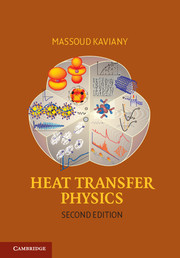Book contents
- Frontmatter
- Dedication
- Contents
- Preface
- Acknowledgments
- 1 Introduction and Preliminaries
- 2 Molecular Orbitals/Potentials/Dynamics and Quantum Energy States
- 3 Carrier Energy Transport and Transformation Theories
- 4 Phonon Energy Storage, Transport, and Transformation Kinetics
- 5 Electron Energy Storage, Transport, and Transformation Kinetics
- 6 Fluid Particle Energy Storage, Transport, and Transformation Kinetics
- 7 Photon Energy Storage, Transport, and Transformation Kinetics
- APPENDIX A Tables of Properties and Universal Constants
- APPENDIX B Derivation of Green–Kubo Relation
- APPENDIX C Derivation of Minimum Phonon Conductivity Relations
- APPENDIX D Derivation of Phonon Boundary Resistance
- APPENDIX E Derivation of Fermi Golden Rule
- APPENDIX F Derivation of Equilibrium, Particle Probability Distribution Functions
- APPENDIX G Phonon Contributions to the Seebeck Coefficient
- APPENDIX H Monte Carlo Method for Carrier Transport
- APPENDIX I Ladder Operators
- Nomenclature
- Abbreviations
- Glossary
- References
- Index
4 - Phonon Energy Storage, Transport, and Transformation Kinetics
Published online by Cambridge University Press: 05 June 2014
- Frontmatter
- Dedication
- Contents
- Preface
- Acknowledgments
- 1 Introduction and Preliminaries
- 2 Molecular Orbitals/Potentials/Dynamics and Quantum Energy States
- 3 Carrier Energy Transport and Transformation Theories
- 4 Phonon Energy Storage, Transport, and Transformation Kinetics
- 5 Electron Energy Storage, Transport, and Transformation Kinetics
- 6 Fluid Particle Energy Storage, Transport, and Transformation Kinetics
- 7 Photon Energy Storage, Transport, and Transformation Kinetics
- APPENDIX A Tables of Properties and Universal Constants
- APPENDIX B Derivation of Green–Kubo Relation
- APPENDIX C Derivation of Minimum Phonon Conductivity Relations
- APPENDIX D Derivation of Phonon Boundary Resistance
- APPENDIX E Derivation of Fermi Golden Rule
- APPENDIX F Derivation of Equilibrium, Particle Probability Distribution Functions
- APPENDIX G Phonon Contributions to the Seebeck Coefficient
- APPENDIX H Monte Carlo Method for Carrier Transport
- APPENDIX I Ladder Operators
- Nomenclature
- Abbreviations
- Glossary
- References
- Index
Summary
Heat transfer by lattice (phonon) conduction is proportional to the lattice thermal conductivity tensor Kp(W/m-K), i.e., qk = −Kp · ∇T (the Fourier law, Table 1.1), and sensible heat storage is determined by the phonon (lattice) specific heat capacity cυ,p (J/kg-K). The specific heat capacity is also given per unit volume(J/m3-K), or per atom(J/K). Phonons participate in many thermal energy conversion phenomena, including laser cooling of solids, discussed in Chapter 7 [ṡi-j(W/m3) in Table 1.1]. In this chapter, we examine how the atomic structure of a solid influences cυ,p, Kp, and ṡi-j involving phonons.
Phonons are lattice-thermal-vibration waves that propagate through a crystalline solid. Most lattice vibrations have higher frequencies than audible sound, ultrasound, and even hypersound. Figure 4.1 shows the various sound- and vibrational-wave regimes. A single, constant speed (dispersionless, i.e., having a linear frequency dependence on the wave number) of 103 m/s is used for the sake of illustration. In solids, the speed of sound is related to the moduli of elasticity and density and is as high as 18, 350 m/s in diamond and as low as 818 m/s in thallium. As will be shown, the vibrational waves have different modes, and the propagation speed can be strongly frequency dependent. The phonon energy ħω is general less than about 0.2 eV, with the high energy phonons being available more at higher temperatures.
In this chapter, we begin with lattice vibration and the relation between frequency and wave number (the dispersion relation) for a simple, harmonic, one-dimensional lattice.
- Type
- Chapter
- Information
- Heat Transfer Physics , pp. 173 - 305Publisher: Cambridge University PressPrint publication year: 2014
- 1
- Cited by



